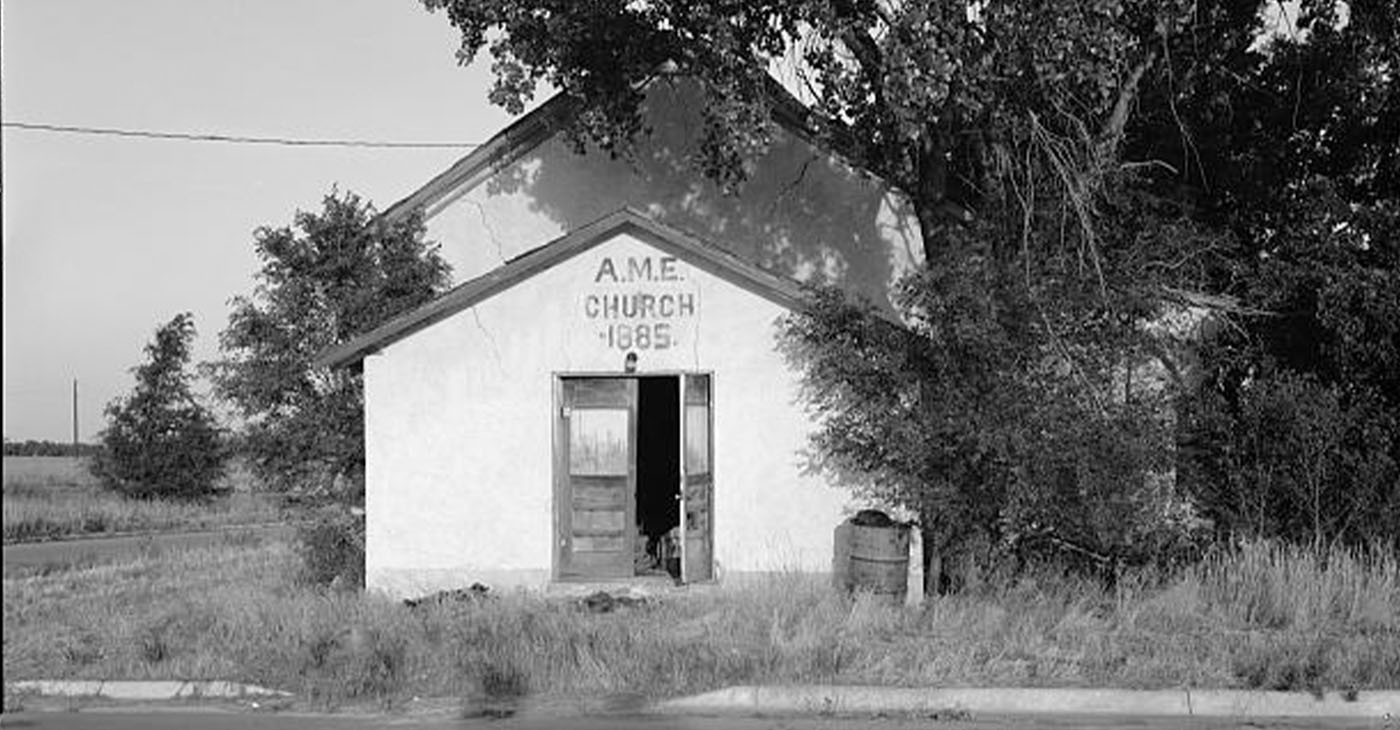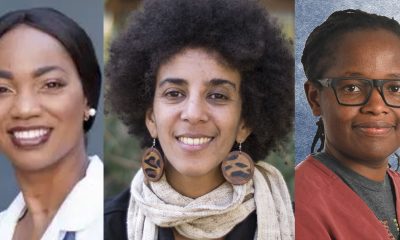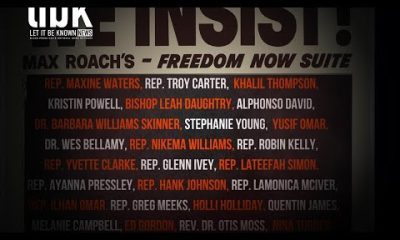#NNPA BlackPress
Randolph: Arizona’s Oldest Historically Black Community
NNPA NEWSWIRE — Often called “freedmen’s towns,” “freedom towns,” or “all-black towns,” African American municipalities were established throughout the United States by or for a largely African American population, many of whom were freed slaves or descendants of slaves. Although a handful of African American towns and communities were established before the American Civil War, it was not until Emancipation that freed Blacks were able to settle in large enough numbers to establish their own communities.
The post Randolph: Arizona’s Oldest Historically Black Community first appeared on BlackPressUSA.

(Part 1 of a series)
Prepared by Jennifer Levstik, WestLand Resources, Inc. and Dianne Post, lawyer for Randolph United Council | Arizona Informant
Established in 1925, the community of Randolph was touted as the newest townsite to rival Phoenix. By the 1930s, however, the community was still a small, rural townsite largely populated by white farmers and ranchers and a handful of African American, Mexican American, and Native American farm laborers. By the next decade, local demographics and settlement patterns had shifted, and the community was largely African American and subdivided along racial lines.
Whites settled to the west of Highway 87 and Blacks to the east of the highway. Over the next several decades, Randolph became a multi-generational African American community—a community that persists to the present day, while many other similar historically Black communities in Arizona have not survived.
The persistence of Randolph and its residents is evidenced in its setting, agrarian qualities, and long-standing cultural history. Even today, community members who have moved away regularly return for holidays, events, family gatherings, funerals, and proudly identify themselves as Randolphians.
Throughout its development, Randolph has continued to retain its racial heritage, expressed both through its population and its built environment, and today it remains the oldest extant historically Black community in Arizona associated with the Great Migration of the early to mid-20th century.
In 2022, the community of Randolph began the process of seeking designation as a Historic District in the National Register of Historic Places. It is expected that the designation will be announced at the end of this year. The following segments are excerpted from the nomination that was prepared for the community on their behalf.
Randolph Historic District (1925–2023)
Randolph, Arizona, is a small agricultural community located approximately 4 miles south of Coolidge and 14 miles equidistant from Florence to the northeast and Casa Grande to the west. The portion of the community that encompasses the proposed historic district is located on the east side of Highway 87, which denotes the highest collection of parcels, buildings, and archaeological sites associated with the persistence of memory of what the community landscape was and still represents to its members.
Randolph has retained its African American identity since its formal establishment in the mid- 1920s through the modern era and derives its significance as the oldest remaining historically Black community in Arizona associated with the Great Migration of the early to mid-20th century.
African American Settlements in the United States
Often called “freedmen’s towns,” “freedom towns,” or “all-black towns,” African American municipalities were established throughout the United States by or for a largely African American population, many of whom were freed slaves or descendants of slaves. Although a handful of African American towns and communities were established before the American Civil War, it was not until Emancipation that freed Blacks were able to settle in large enough numbers to establish their own communities.
It is estimated that between 1865 and 1915, at least 60 Black communities were created across the United States, with close to 20 in Oklahoma alone. The peak of Black settlement was in the 1920s, but in the western states—particularly Arizona and New Mexico—the trend continued into the 1940s. The exact number of these communities and towns is unknown, and estimates vary widely depending on the source.
The earliest freedom settlement established in what would later become part of the United States was Fort Mose. Fort Mose was founded in 1738 near present-day St. Augustine, Florida, a former Spanish colony. The community was populated by about 100 people escaping slavery, primarily from Georgia and the Carolinas.
They fled to Florida following a Spanish Edict of 1693 that stated that any enslaved male on an English plantation who escaped to Spanish-held Florida would be granted freedom if they converted to Catholicism or joined the Spanish militia. Many of the Black men that came to form this early settlement were blacksmiths, carpenters, farmers, boatmen, and cattlemen. Eventually women and children also joined the settlement.
Two years after its founding, during the War of Jenkin’s Ear, the British attacked the Spanish city of St. Augustine, targeting Fort Mose in an effort to return the former slaves to English-held plantations. After a hard-fought battle, the Spanish and Fort Mose settlers successfully expelled the British forces, and for the next 80 years of Spanish control of Florida, Fort Mose remained a haven for fugitive slaves. When Florida became part of the United States, the residents of Fort Mose fled to Cuba.
The number of Black settlements in the United States remained relatively low until Post-Civil War Reconstruction. In 1877, the first great wave of Black migration began when many newly freed slaves feared that the removal of federal troops from the American South would lead to unrest and retaliation. In response, many chose to move west.
The first Black community to be established west of the Mississippi River was Nicodemus, Kansas. It was widely advertised to prospective settlers as the “Largest Colored Colony in America,” with promises that land could be purchased for as little as a one-dollar deposit. In 1878, a year after Nicodemus was established, a large group of 380 African Americans from Kentucky made the arduous wagon trip to Kansas.
Upon their arrival, they discovered that Nicodemus was a flat, desolate town populated with sod dugouts. Many of the original settlers arriving from Kentucky took one look and turned around, but for those who stayed, the town eventually grew from sod to frame homes and had a baseball team, a post office, churches, schools, social clubs, an ice cream parlor, and two newspapers.
Upwards of 800 people at one time resided in the town during its peak. When word came that a rail station was proposed for the town, its population exploded, as did its influence in state politics. Nicodemus grew large enough that town leaders were able to push forward the election of the state’s first Black politicians to represent their interests.
This prosperity was short-lived, however, as the town was bypassed by the railroad, forcing many residents to leave. By 1910, only 400 people remained.
In the early 1900s, Oklahoma became a popular choice for resettlement by African Americans. One of the most successful communities, Boley, escaped the troubles of Nicodemus by having both railroad access and arable land for farming. By 1907, it boasted 1,000 residents in town, with many others who owned farms on the town’s edges.
Boley was so successful that prominent African American leader Booker T. Washington pointed to Boley as an example of a community success story, and it influenced the creation of the Black town of Mound Bayou in Mississippi. When Oklahoma gained statehood in 1907, however, Boley faced new discrimination as the Democratic party gained control of the state legislature. Newly enacted Jim Crow laws led to disenfranchisement and the slow dismantling of a once thriving town.
Although Oklahoma and Texas had the largest numbers of Black towns in the United States, at least nine similar towns were established in other western states, including Nebraska, California, New Mexico, Colorado, and Arizona. The towns of Allensworth in California, DeWitty in Nebraska, and Deerfield in Colorado had all been established by 1910.
Black communities in Arizona and New Mexico were established in the 1920s and 1930s, with thriving Black populations well into the 1950s. The five known Black migrant communities established in Arizona were Allenville, Mobile, McNary, Randolph, and Rillito. Because many of these communities were never incorporated and records were not kept of their existence, the probability remains that other such communities were established in Arizona.
Black settlements were often created for the same reasons all towns are created—to provide opportunities for economic advancement and money for speculators and to exploit natural resources. They differed, however, in that they not only sought economic and social freedom but also racial uplift. The communities were a haven from discrimination, lynching, and marginalization—a place where individuals and families could thrive without fear.
One of the strongest proponents of Black settlements was Booker T. Washington, a former slave who, among his many accomplishments, founded the Tuskegee Institute in Alabama.
During his career as an educator, author, orator, and presidential advisor, Washington played a role in helping establish and promote the idea of all-Black towns, including Mound Bayou in Mississippi, Gambling in Louisiana, Hobson City in Alabama, and Eatonville in Florida.
He encouraged Blacks to create their own communities in the face of segregationist policies, viewing these communities as one of the few ways for African Americans to have some autonomy in a country that did not see them as equal. And, for a short time, Washington was right.
Soon, however, the states that once offered a safe haven introduced policies that made establishment of such communities either more difficult or nearly impossible to maintain. Interestingly, through the mid-twentieth century, southwestern states became more appealing as a destination for African Americans until they, too, began to impede Blacks seeking economic and social advancement.
As a result of the lawsuit against SRP, Randolph is re-organizing, growing, and developing. They have formed a 501(c)3 organization Randolph United Council. If you can contribute to the community, please send donations to: Randolph United Council, P.O. Box 1869, Coolidge, Az 85128
The post Randolph: Arizona’s Oldest Historically Black Community first appeared on BlackPressUSA.
#NNPA BlackPress
Rep. Al Green Files Articles of Impeachment Against President Trump
BLACKPRESSUSA NEWSWIRE — Rep. Green told Newsweek that he is moving on impeachment now before “tanks are rolling down the street.”

By Lauren Burke
Congressman Al Green (D-TX) has filed articles of impeachment against President Trump. Rep. Green, 77, has served in Congress since 2005. President Trump is the only President who has been impeached twice by the U.S. House of Representatives. Rep. Green told Newsweek that he is moving on impeachment now before “tanks are rolling down the street.” The impeachment resolution filed by Rep. Green on May 19, states that President Trump is, “unfit to represent the American values of decency and morality, respectability and civility, honesty, and propriety, reputability, and integrity, is unfit to defend the ideals that have made America great, is unfit to defend liberty and justice for all as extolled in the Pledge of Allegiance, is unfit to defend the American ideal of all persons being created equal as exalted in the Declaration of Independence, is unfit to ensure domestic tranquility, promote the general welfare and to ensure the blessings of liberty to ourselves and our posterity as lauded in the preamble to the United States Constitution, is unfit to protect government of the people…” Whether Rep. Green can force a vote in the U.S. House on impeachment remains an unknown issue. President Trump was impeached on December 18, 2019, for abuse of power and obstruction of Congress. He was then impeached a second time on January 13, 2021, for “Incitement of insurrection” in the wake of the violent January 6, 2021 attack on the U.S. Capitol by Trump’s supporters.
The White House stated Black Press USA on Rep. Green’s effort to impeach the President. “This week, Democrats ousted their DNC ‘leader,’ opposed the largest tax cut in history, and were exposed for actively covering up Joe Biden’s four-year cognitive decline. Now, Democrats have turned their sights to threatening impeachment. We are witnessing the collapse of the Democrat Party before our eyes. Not a single one of these efforts will help the American people. The contrast could not be more clear: President Trump is fighting for historic tax relief for the American people, Democrats are fighting themselves,” said White House Deputy Press Secretary Anna Kelly in a written statement. Several decisions and legal interpretations by the Trump Administration are currently being challenged in federal court. On May 15, the U.S. Supreme Court debated the issue of birthright citizenship after a legal challenge on the issue by the Trump Administration.
During that legal challenge, Justice Ketanji Brown Jackson challenged Trump’s solicitor general Dean John Sauer by saying, “Your argument seems to turn our justice system into a catch-me-if-you-can kind of regime … where everybody has to have a lawyer and file a lawsuit in order for the government to stop violating people’s rights.” Rep. Green’s impeachment resolution also focused on the issue of ignoring judicial orders by the executive branch. A notable example was the deportation case of Maryland father Kilmar Abrego Garcia. Garcia was deported to a prison in El Salvador by federal officials on March 15, 2025.“The Constitution does not tolerate willful disobedience of judicial orders — especially by officials of a coordinate branch who have sworn an oath to uphold it. To permit such officials to freely ‘annul the judgments of the courts of the United States’ would not just ‘destroy the rights acquired under those judgments’; it would make a solemn mockery’ of ‘the constitution itself.’” “You have no mandate,” Congressman Green stood up and yelled at President Trump during his State of the Union Speech on March 4. After the incident, Republicans who control the U.S. House considered sanctioning Rep. Green, but they did not complete an action against him.
#NNPA BlackPress
Affordable Childcare Remains a Barrier: Solutions in New Report
BLACKPRESSUSA NEWSWIRE — We also still haven’t put a dent in affordability for working families. That’s why we urgently need increased funding and new solutions.”

While America’s childcare supply grew nationally, the price of that care continues to rise—placing affordable, high-quality care out of reach for many families. A new report released by Child Care Aware® of America (CCAoA), Child Care in America: 2024 Price & Supply, shows that despite promising signs of increased supply, affordability remains a major barrier — and underscores the need for increased sustained federal and state investment.
From 2023 to 2024, the number of childcare centers increased by 1.6% (to 92,613) and the supply of licensed family childcare (FCC) homes increased by 4.8% (to 98,807). The national growth in FCC homes’ supply is driven largely by four states (CA, KS, MA, VA) and is especially notable as it reverses a year-long downward trend.
At the same time, the national average price for childcare rose by 29% from 2020 to 2024, outpacing inflation and exceeding other major family household expenses like rent or mortgage payments in many states. Childcare is now so expensive that it consumes 10% of a married couple with children’s median household income and a staggering 35% for a single parent. In most states, families pay more for childcare than rent, mortgage payments, or in-state university tuition.
“Childcare supply is increasing, and that is a win—but it’s not enough,” said Susan Gale Perry, Chief Executive Officer of CCAoA. “Recent federal and state pandemic-era investments have stabilized and grown supply in some places, but a significant supply gap still exists — especially in rural communities and for infants and toddlers. We also still haven’t put a dent in affordability for working families. That’s why we urgently need increased funding and new solutions.”
CCAoA’s Childcare in America: 2024 Price & Supply report also found that:
- The average price of childcare increased by 29% from 2020 to 2024, outpacing the national inflation rate of 22%.
- In 45 states plus Washington, DC, the average annual price of center-based childcare for two children exceeded mortgage payments, in some states by up to 78%.
- In 49 states plus Washington, DC, the price of center-based childcare for two children exceeded median rent payments ranging from 19% to over 100%.
- In 41 states plus Washington, DC, infant care in a center cost more than in-state university tuition.
CCAoA urges policymakers to increase childcare funding at both state and federal levels to maintain the momentum of growing supply, address rising prices, and expand access to childcare for families. Federal funding increases have fallen short of the need and our research shows that total state investments in child care or preschool vary widely from state to state, putting children, families, and communities across America on an uneven playing field. Further, targeted investments in childcare supply building and stabilization and childcare workforce recruitment and retention strategies are essential to help sustain an adequate supply of high-quality childcare options nationwide.
Child Care Aware® of America (CCAoA) is the only national organization that supports every part of the childcare system. Together with an on-the-ground network of people doing the work in states and communities, it helps America become child care strong by providing research that drives effective practice and policy, building strong child care programs and professionals, helping families find and afford quality child care, delivering thought leadership to the military and direct service to its families, and providing a real-world understanding of what works and what doesn’t to spur policymakers into action and help them build solutions.
#NNPA BlackPress
Sex, Coercion, and Stardom: Diddy Case Mirrors Music’s Ugly History
BLACKPRESSUSA NEWSWIRE — It started with a Reddit post that didn’t just speculate on Diddy’s fate but questioned the very foundations of the culture that made him

By Stacy M. Brown
Black Press USA Senior National Correspondent
As Sean “Diddy” Combs faces a federal sex trafficking case and the slow unraveling of his once-untouchable legacy, a larger question looms: Is this the moment the music industry finally confronts its darkest secrets?
It started with a Reddit post that didn’t just speculate on Diddy’s fate but questioned the very foundations of the culture that made him: “How much damage could Diddy do to the state of hip hop?” the user asked. “Supposedly, he has incriminating evidence against those who attended his parties. The same parties that had a lot of bad things happen, to say the least.” The implication was chilling—if Diddy were to cooperate with federal authorities, the fallout might not stop at his feet. Names floated in the post—Jay-Z, Beyoncé, Usher, Justin Bieber—aren’t confirmed in any court filings, but their inclusion highlights the breadth of Diddy’s influence and the potential reach of any revelations. If even a fraction of the speculation proves true, the reverberations wouldn’t stop at hip-hop—they’d hit every corner of the music industry. For his part, Combs denies all allegations. His legal team has described the now-infamous “freak-offs” as consensual encounters, part of his non-monogamous lifestyle. But prosecutors allege something much more sinister: a criminal enterprise powered by the machinery of his music and business empire—one that trafficked women, coerced labor, obstructed justice, and used influence and intimidation to maintain control. Still, for all the headlines Combs generates, his alleged crimes do not exist in isolation. The music industry has long tolerated, enabled, and even glamorized behavior that would trigger career-ending consequences in other arenas. Diddy’s story might be shocking—but it’s not new.
Rock music has its own rogue’s gallery. Jerry Lee Lewis nearly destroyed his career in 1958 after marrying his 13-year-old cousin. Elvis Presley met 14-year-old Priscilla Beaulieu when he was 24 and later moved her into his home in Memphis. In more recent years, Aerosmith’s Steven Tyler faced (and ultimately evaded) a lawsuit from a woman who says he sexually assaulted her in the 1970s when she was 17. A judge dismissed the case due to the statute of limitations. Phil Spector, the genius producer behind the “Wall of Sound,” died in prison after being convicted of murdering actress Lana Clarkson. Gary Glitter was convicted of possessing child pornography and later child sex abuse. Kid Rock and Creed frontman Scott Stapp were filmed with strippers in a sex tape that leaked online in 2006. A new biography of the Rolling Stones claims Mick Jagger had sexual relationships with at least two of his male bandmates, raising further questions about the power dynamics inside even the most celebrated groups.
Journalist Ann Powers, writing for NPR, once noted that the “history of rock turns on moments in which women and young boys were exploited in myriad financial, emotional and sexual ways.” Powers added: “From the teen-scream 1950s onward, one of the music’s fundamental functions has been to frame and express sexual feelings for and from the very young… relating to older men whose glamour and influence encourages trust, not caution.” This brings the spotlight back to Diddy—not just as an accused individual but as a symbol. He was once the archetype of success: Harlem-born mogul, founder of Bad Boy Records, and kingmaker behind artists like Notorious B.I.G., Faith Evans, Ma$e, 112, and French Montana. He transformed hip-hop into a global business and amassed influence far beyond the recording booth. He sold more than 500 million records, earned multiple Grammy Awards, and was honored by MTV, Howard University, and the City of New York—until those honors were swiftly revoked after a video surfaced showing him physically assaulting singer Cassie Ventura. Ventura, his longtime partner and protégé, has accused Combs of brutal physical abuse and psychological control. Her lawsuit and the video evidence ignited a wave of allegations from other women and men, describing similar patterns of coercion, manipulation, and fear. “This is not just about bad behavior. This is about systemic exploitation and abuse made possible by fame, money, and silence,” said one advocate for survivors in the entertainment industry.
While hip-hop has long been a target of criticism for misogyny and violence, what’s now being laid bare is a broader, genre-defying truth: from rock and pop to hip-hop and beyond, the music industry has operated for decades without accountability for its biggest stars. “Sex isn’t the problem,” one Reddit user responded. “Coercion via job opportunities is.” Another added, “Zero [impact], just like R. Kelly and MJ did zero to R&B,” referencing the R&B superstar’s conviction and Michael Jackson’s controversial legacy. Others argued hip hop would endure, regardless of Combs’ fate. Maybe it will. But the Diddy scandal pulls back the curtain—not just on the parties, the rumors, or the headlines—but on an industry-wide culture that has, for too long, allowed power to shield predation. As one survivor put it outside a recent court appearance: “This isn’t just a hip hop problem. It’s not even just a music problem. It’s a power problem.” And now, the music industry has to decide: Will it finally tune in, or will it keep playing the same old song?
-

 Activism4 weeks ago
Activism4 weeks agoAI Is Reshaping Black Healthcare: Promise, Peril, and the Push for Improved Results in California
-

 Activism4 weeks ago
Activism4 weeks agoBarbara Lee Accepts Victory With “Responsibility, Humility and Love”
-

 Activism4 weeks ago
Activism4 weeks agoESSAY: Technology and Medicine, a Primary Care Point of View
-

 Activism4 weeks ago
Activism4 weeks agoNewsom Fights Back as AmeriCorps Shutdown Threatens Vital Services in Black Communities
-

 Activism4 weeks ago
Activism4 weeks agoFaces Around the Bay: Author Karen Lewis Took the ‘Detour to Straight Street’
-

 Arts and Culture4 weeks ago
Arts and Culture4 weeks agoBOOK REVIEW: Love, Rita: An American Story of Sisterhood, Joy, Loss, and Legacy
-

 #NNPA BlackPress4 weeks ago
#NNPA BlackPress4 weeks agoThe RESISTANCE – FREEDOM NOW
-

 Alameda County4 weeks ago
Alameda County4 weeks agoOUSD Supt. Chief Kyla Johnson-Trammell to Step Down on July 1












































